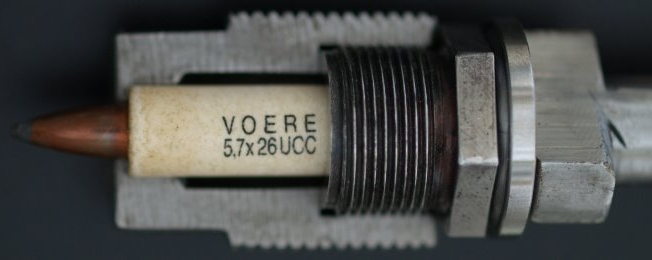




 Dummy
Dummy

 Proof
Proof

 In all probability some prototype loading with different dimensions
In all probability some prototype loading with different dimensions
The following article was taken from GUNS REVIEW MAGAZINE, NOV 1993
Voere caseless cartridges in a sporting rifle
THE SEARCH for an efficient caseless cartridge system for firearms has been under way for many years. Heckler & Koch have reportedly spent huge sums of money trying to perfect an efficient system for military use, but without success. In military terms, caseless ammunition would make a lot of sense. The complete cartridge is much lighter than standard cased ammunition, producing a weight saving which is.very important in a military context. Perhaps as important, when caseless ammunition is used from inside an armoured vehicle, there are no empty cases rattling around. –
The application of caseless ammunition to the sporting rifle market is less easy to understand. A rifle made to fire caseless ammunition will not use anything else. The caseless round is complete in itself and factory made ammunition must be acquired. Reloading is out of the question. The sporting rifleman has no problems with the weight of ammunition he must carry and no problems with recovering his cases from the field or from the range. Many were therefore surprised when Austrian rifle makers Voere announced their VEC 91 rifle, a bolt action sporter designed to fire their own 5.7×26 UCC caseless round. The rifle itself appears to be a standard sporter. It has a five shot detachable box magazine, apparently standard trigger, tang safety, a nice walnut stock with a slightly ‘hog’s back’ buttstock and graceful fore-end. The full pistol grip has a comfortable palm swell and the stock is chequered at the hand and on the fore-end. The standard-looking barrel is fully floating and the apparently standard bolt has twin forward locking lugs. It is necessary to handle the rifle to find that, although it looks and feels perfectly normal, there are differences. Difference number one is found in the pistol grip cap which is coin slotted. Underneath the cap are two readily available batteries to power the electric ignition. The makers claim that the batteries are good for about 5,000 shots. The bolt too is different. The bolt head has double gas seals and wraps around the base of the cartridge to prevent rearward gas leaks on firing. This obturation has been one of the stumbling blocks for all caseless ammunition, just as it was in the day of the early paper cartridge breech loaders before the advent of the brass cartridge case. The major difference in the rifle will be found in the trigger. This is not electronic release of a mechanical trigger to strike a percussion cap, this is true electronic ignition. Instead o’f a standard primer, the cartridge uses a semi-conductor. The trigger is therefore no more than a simple electric switch.
There is no required length of movement and no required pull. In fact, the trigger can be regulated for a let-off weight of between half an ounce and seven pounds. The trigger movement is very short and sharp, with no break point. It takes a little getting used to being devoid of all the features of movement in ordinary triggers. It is simply a matter of pressing a switch with the trigger finger. There is no measurable lock time with this system. The semi-conductor will not react to pressure or impact. The cartridge can be crushed or the primer struck repeatedly, but it cannot fire. The system is claimed to be much more reliable than any mechanical ignition system with its triggers, sears and links, all small, all liable to wear and all liable to loss of adjustment. The semi-conductor will operate only if subjected simultaneously to a voltage of 18V and a current of 500mA. It cannot be ignited by external electrical forces such as static build-up.
The cartridge itself has an overall length of 1.46 inches, the propellant body being 1.035 inches long and 0.355 inches in diameter. An extractor groove is cut into the head which is about 0.060 inches deep and 0.14 inches wide. This is to allow the removal of an unfired cartridge. There is nothing to remove when the cartridge has been fired. The semi-conductor primer can be seen in the head of the cartridge. The cartridge is a very smooth, dense, cream-coloured material, which is very hard but not brittle. It seems to be impervious to all the usual possible hazards such as water, oils etc. It withstands hard wear. One was carried in a pocket full of small change for a full week without showing the slightest sign of wear. The bullet is a standard 55 grain hollow point. The reported muzzle velocity is 3300 fps. The complete cartridge weighed 76.5 grains on our scale.
The caseless cartridge is effectively the .223 sporter and for comparison a Remington 223 cartridge with a soft point bullet is 2.180 inches long and the case is 1.750 inches long and 0.373 inches diameter at the head. The complete cartridge weighs 176 grains, over twice as much as the caseless round. Velocities are effectively the same.

